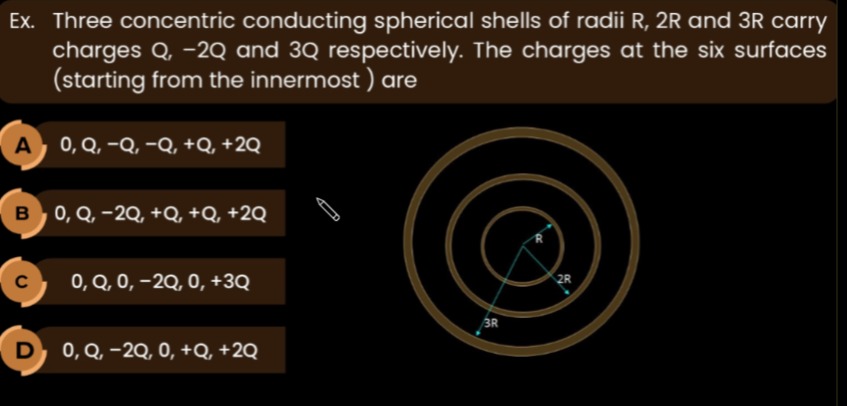Question
Question: Three concentric conducting spherical shells of radii R, 2R and 3R carry charges Q, -2Q and 3Q respe...
Three concentric conducting spherical shells of radii R, 2R and 3R carry charges Q, -2Q and 3Q respectively. The charges at the six surfaces (starting from the innermost ) are

0, Q, -Q, -Q, +Q, +2Q
0, Q, -2Q, +Q, +Q, +2Q
0, Q, 0, -2Q, 0, +3Q
0, Q, -2Q, 0, +Q, +2Q
A 0, Q, -Q, -Q, +Q, +2Q
Solution
The problem involves finding the charge distribution on the surfaces of three concentric conducting spherical shells. The radii are R, 2R, and 3R, and the total charges on the shells are Q, -2Q, and 3Q respectively. Let the shells be denoted as S1,S2,S3 from innermost to outermost.
For a conductor in electrostatic equilibrium, the electric field inside the conductor is zero. Also, any net charge on a conductor resides on its surface. For a hollow conductor, the charge can be distributed on both the inner and outer surfaces.
Shell S1 (radius R, total charge Q1=Q):
Let q1,in and q1,out be the charges on the inner and outer surfaces of S1.
q1,in+q1,out=Q1=Q.
Consider a Gaussian surface within the material of S1. The electric field is zero, so the total charge enclosed is zero. The only charge enclosed is q1,in. Thus, q1,in=0.
Then, q1,out=Q−q1,in=Q−0=Q.
Charges on S1: inner surface 0, outer surface Q.
Shell S2 (radius 2R, total charge Q2=−2Q):
Let q2,in and q2,out be the charges on the inner and outer surfaces of S2.
q2,in+q2,out=Q2=−2Q.
Consider a Gaussian surface within the material of S2. The electric field is zero, so the total charge enclosed is zero. The charges enclosed are the total charge on S1 and the charge on the inner surface of S2.
Total charge enclosed = Q1+q2,in=Q+q2,in.
Since the total charge enclosed is zero, Q+q2,in=0, which gives q2,in=−Q.
Then, q2,out=Q2−q2,in=−2Q−(−Q)=−2Q+Q=−Q.
Charges on S2: inner surface -Q, outer surface -Q.
Shell S3 (radius 3R, total charge Q3=3Q):
Let q3,in and q3,out be the charges on the inner and outer surfaces of S3.
q3,in+q3,out=Q3=3Q.
Consider a Gaussian surface within the material of S3. The electric field is zero, so the total charge enclosed is zero. The charges enclosed are the total charge on S1, the total charge on S2, and the charge on the inner surface of S3.
Total charge enclosed = Q1+Q2+q3,in=Q+(−2Q)+q3,in=−Q+q3,in.
Since the total charge enclosed is zero, −Q+q3,in=0, which gives q3,in=Q.
Then, q3,out=Q3−q3,in=3Q−Q=2Q.
Charges on S3: inner surface Q, outer surface 2Q.
The charges at the six surfaces, starting from the innermost, are:
- Inner surface of shell with radius R: q1,in=0
- Outer surface of shell with radius R: q1,out=Q
- Inner surface of shell with radius 2R: q2,in=−Q
- Outer surface of shell with radius 2R: q2,out=−Q
- Inner surface of shell with radius 3R: q3,in=Q
- Outer surface of shell with radius 3R: q3,out=2Q
The sequence of charges is 0, Q, -Q, -Q, Q, 2Q.
Comparing this sequence with the given options, option A matches our calculated charges.
